People
Justin Hitchcock
1752-1822
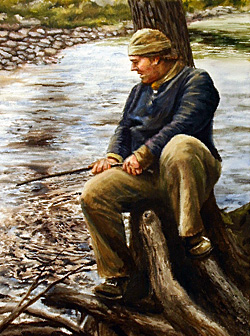
Justin Hitchcock
© 2008 Bryant White
Prologue
Justin Hitchcock was a man of many talents. In addition to practicing his trade as a hat maker, Justin was at various times in his life a farmer, deacon, town clerk, singing teacher, music director, and soldier. He liked to work with his hands; he built his own house, including making his own bricks. When he wanted a bass viol, he built his own. He also wrote a revealing, 87-page autobiography. (1)
Justin Hitchcock was born to Luke and Lucy Merrick Hitchcock in Granville, Massachusetts, in 1752. He was the third of 11 children. Typical of many boys in his time, he served an apprenticeship from the age of 14 until he was 21. Hitchcock's apprenticeship (or indenture) began in 1766 when he and his father agreed that he would learn the trade of hat making from Moses Church of Springfield, Massachusetts. Justin agreed to live with Church while learning the hat making trade, "Honestly and faithfully Sere His Secrets," and agreeing to Church's rules of behavior. These rules included refraining from playing cards and swearing, and not frequenting taverns. In return, Church agreed to teach Justin "the trade Art or mystery of Hat making & to Read write cipher" and provide "Good Sufficient meat Drink Lodgings wearing Aparrel & washings & Provide for Him two suits of Apparril." (2)
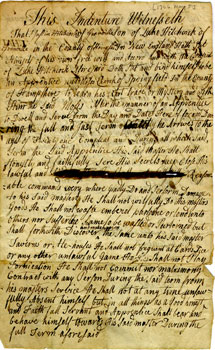
This indenture bound 14-year-old Justin Hitchcock for seven years to Benjamin Church of Springfield, Massachusetts, to learn "the trade Art or mystery of Hat making & to Read write cipher."
More info
Courtesy Pocumtuck Valley Memorial Association, Deerfield, MA
Justin completed his indenture and moved to Deerfield, Massachusetts, in 1774. He marched to Cambridge as a fifer with a Minuteman company in April, 1775. Although a military roster from Deerfield records that Justin served "a tour in April 1775 8 months," (3) his autobiography reveals that he hired a Sudbury man to take his place for $10. (4) Justin took up his fife and gun again in 1777 when he joined the massive mobilization of militia to stop the British army's invasion from Canada.
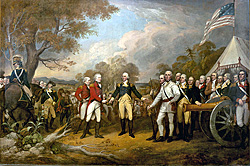
Like many other men from western Massachusetts, Justin witnessed the surrender of General John Burgoyne and his army at Saratoga, New York, in 1777.
Courtesy Capitol Rotunda, US Government, Washington DC
One year later, Justin purchased an acre of land and began building a house. In 1779 he recorded in his autobiography that he "had made brick the last year and carted about 30 loads of stone and this winter I got the timber." The house was raised in May of 1779, and he married Mercy Hoyt of Deerfield the following November. The Revolution had divided many communities, and Deerfield was no exception. Like the town's minister and some other prominent residents, Mercy's father held Loyalist sympathies. In contrast, Justin was a strong Whig, or patriot. Perhaps a letter Justin wrote asking the Hoyts to look beyond the fact that "our public affairs are in so unhappy a situation" and assurance of his affection for Mercy, persuaded her parents to assent to the marriage, despite their political differences. (5)
In 1779, Hitchcock was voted town clerk. This was a time when Loyalists had succeeded in wresting control of many town offices away from the Whigs/Patriots who had previously controlled town affairs. Hitchcock believed that he was elected because, "As I attended public worship and led the singing, I thought the Tories might have some hope of gaining me to their side by this mark of distinction." Justin's marriage to Mercy Hoyt might also have played a role in his election. He was not swayed, however, and was voted out in 1781, when the Whig element once again overwhelmed the Loyalists. He would not serve as town clerk again until 1804. (6)
In 1780, Hitchcock purchased a small single-story building situated near the common and moved it to his property to serve as a hat making shop. Justin and Mercy's first child, Charissa, was born in 1781, and the family would include five children by 1793. Besides Charissa, there were Henry, Charles, Edward and another daughter, named Emilia. (7)
Both his army service as a fifer and his autobiography reveal that one of Justin Hitchcock's chief interests was music. As a boy in school, "I had a chance to gratafy my wish by learning to sing notwithstanding I had supposed I could go on very well provided I learnt the rules but when this was so far compleated as to pass to tuneing the voise and attemping to sing I found I knew nothing and I made awkward work of it especially beating time." Justin's singing school master gave his students "the task of beating time and singing the tune at first and must get the piece given out the evening before so well as to sing it and beat the time singly before the whole school." (8) Despite the fact that he was accused of being one of "the most awkward of the singers" and told that he wasn't capable of learning, Justin persevered and led the church choir for many years. (9)
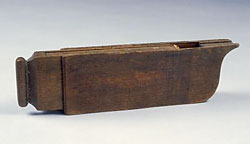
Staying in tune was a challenge for church choirs in this period, as they generally sang without musical accompaniment. Justin Hitchcock used this pitchpipe to tune singers at meetinghouse services.
Courtesy Pocumtuck Valley Memorial Association, Deerfield, MA
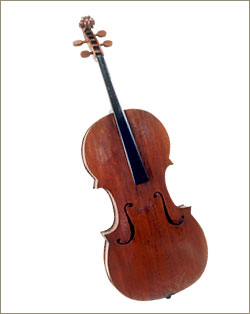
At a time when musical accompaniment during Congregational services was the exception rather than the rule, Justin Hitchcock built this bass viol to accompany the choir.
Courtesy Pocumtuck Valley Memorial Association
Shays' Rebellion
Like other Deerfield residents, the Hitchcocks greeted the end of the war with relief and optimism. Justin was a frequent customer at John Williams' store during the fall of 1783, and Williams was happy to sell Justin's hats. But, as in other states, the economic situation in Massachusetts rapidly deteriorated. Hitchcock vividly recalled the difficult economic conditions in his autobiography:
Our publick affairs [in 1784] wore a very gloomy aspect money was scarce taxes called for often. And people getting into debt at the stores And a spirit of insubordination began to show itself and the Government complained of as the cause tho it was evident they did all they could to ease the people of their burdens but they had not the power to do it. They made a tender act and many a debt which ought to have been paid in Money was paid at the last of an execution in pine boards bulls and slags a they were prised off to the creditor (10)
Justin noted that at the time, he owed money both for his land and workshop, yet felt fortunate that although he had purchased some meadow land, he was able to pay for it with cash (a note of 23 dollars) because he had "very wisely hired" it out. In 1785 he built a small barn to house his cattle and hay. He was able to reframe it with new timbers but gave it a board rather than a shingle roof. He noted that the barn served him quite well through the severe winter. (11)
In 1785, the times grew still harder for many people. Justin noted that "Their was much complaining and uneeasness And proposals for County Conventions and other popular meetings to advis what was best to be done Those however did no good but served to inflame the public mind." When mobs prevented the Northampton Court of Common Pleas from sitting in August of 1786, the government called for armed militia to protect the Supreme Court, due to be held in Springfield in September. Hitchcock joined about 40 other Deerfield men and marched to Springfield to protect the courthouse. Over the 24 hours it took them to get there, Hitchcock recalled that "The Mob turned out at the same time and we frequently passed them as they was on the road but was no dispute." On their arrival, Justin's militia group found the courthouse already well guarded by "the friends of Government," but Hitchcock noted that the court was not able to accomplish any business because of the "noise and confusion" of the protesters surrounding the building. Hitchcock judged the size of the mob to be around 1200-1300 men and noted that around 300 appeared to be armed while the others were not.Although all of the "friends of Government" were armed, Hitchcock observed that the "mob" outnumbered them. Eventually, the court adjourned and Hitchcock noted that "a sort of agreement was entered into" and all returned home peacefully. (12)
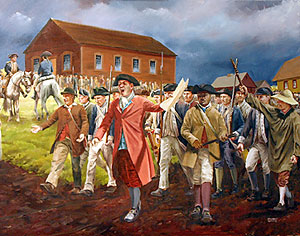
Justin Hitchcock joined the hundreds of men converging on Springfield. Some came to stop the Supreme Court from convening, while others, like Hitchcock, marched with the government militia to protect the court and the justices. Detailo from Petition and Protest
© 2008 Bryant White
Justin recorded that by the end of 1786, "all law and goverment was compleatly prostrate. In Worcester Hampshire and Berkshire [Counties] James Bowdoin Esq. was now our Governor and he and the Council with the Genl Court were about trying whether they should rule or a Mob." In January 1787, the conflict reached "truly an alarming crisis." Although Justin does not appear to have actively taken part in any further militia activity, he described in detail the encounter at the United States Arsenal in Springfield on January 25, 1787. When the government militia stationed at the Arsenal fired upon the advancing columns, Hitchcock recalled that "The insurgents as the mob was now called scattered in every direction" and that Captain Shays' leadership was highly criticized:
it was said that Shays was backward to head them That he was constantly surrounded with a council of old men who rode on each flank in this attack And when they saw the effect of the Artillery they turned their horses about and called a loud to the armed men to do so which had the effect they desired and Shays and his officers could as well command the wind as the men he headed (13)
In his final comment on the rout of Shays and his remaining men at Petersham by General Lincoln's government militia on February 4, 1787, Justin Hitchcock revealed his contempt for the men he called "the mob": "so this concluded the farce."(14)
Hitchcock could not have been more pleased with the creation and adoption of the new Federal Constitution, and was convinced that "the insurrection in Massachusetts" played a key part in bringing it about:
In September this year the convention of the United States met at Philadelphia to adopt a constitution for the states This was an important and necessary measure. Congress under the confederation possessed no power to enforce their resolutions and individual states were too jealous of each other to act in concert in any national transaction. And the insurrection in Massachusetts plainly skewed the necessity of a National Government. And it is likely hastened on the adoption of it the convention chose Genl Washington their President and formed the constitution under which we live Other Nations have had their Governments establish by the sword here then was anovel scene a great people sending their greatest men to form for them in a peaceable and tranquil manner a form of government which was to be binding on them and their Posterity And they happily suceeded (15)
Epilogue
Justin Hitchcock died without leaving a will in February of 1822, at the age of 70. His oldest son, Henry, acquired the home Justin had so painstakingly built. Another son, Edward, created a silhouette of his father just before Justin's death. Edward Hitchcock inherited his father's lively intellect and curiosity. He displayed an early interest in science—particularly astronomy, and religion. Justin sent Edward to Yale, where he studied divinity. After serving as pastor of a parish in Conway, Massachusetts, Edward taught geology, mineralogy, and natural science at Amherst College. He served as state geologist for Massachusetts and, in 1844, became President of Amherst College.
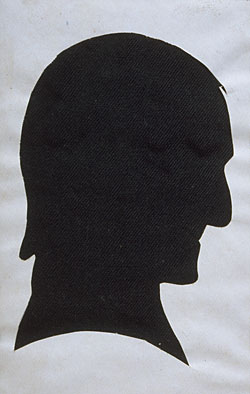
Edward Hitchcock created this silhouette of his father shortly before Justin died in 1822.
Courtesy Pocumtuck Valley Memorial Association, Deerfield, MA
About This Narrative
Note: All narratives about people are, to the extent possible, based on primary and secondary historical sources.
See Further Reading for a list of sources used in creating this narrative. For a discussion of issues related to telling people's stories on the site, see: Bringing History to Life: The People of Shays' Rebellion
| Print | Top of Page